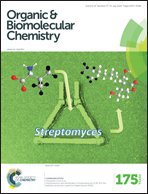Synthesis and evaluation of influenza A viral neuraminidase candidate inhibitors based on a bicyclo[3.1.0]hexane scaffold†
Abstract
This manuscript describes a novel class of derivatives based on a bicyclo[3.1.0]hexane scaffold, proposed as mimics of sialic acid in a distorted boat conformation that is on the catalytic pathway of neuraminidases (sialidases). A general synthetic route for these constrained-ring molecules was developed using a photochemical reaction followed by a Johnson–Corey–Chaykovsky cyclopropanation. Functionalization with the goal of occupying the 150-cavity was also exploited. Inhibition assays demonstrated low micromolar inhibition against both group-1 (H5N1) and group-2 (H9N2) influenza neuraminidase subtypes, indicating good affinity for the alpha and beta sialic acid mimics and 150-cavity-targeted derivatives. These results provide a validation of a bicyclo[3.1.0]hexane scaffold as a mimic of a distorted sialic acid bound in the neuraminidase active site during catalysis.
![Graphical abstract: Synthesis and evaluation of influenza A viral neuraminidase candidate inhibitors based on a bicyclo[3.1.0]hexane scaffold](/en/Image/Get?imageInfo.ImageType=GA&imageInfo.ImageIdentifier.ManuscriptID=C6OB00999A&imageInfo.ImageIdentifier.Year=2016)

 Please wait while we load your content...
Please wait while we load your content...